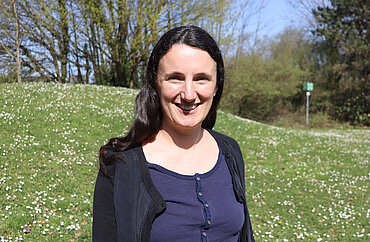Anaïs Bardet, CNRS researcher, obtains her Habilitation à diriger des recherches
Congratulations to Anaïs Bardet who received her Habilitation à diriger des recherches (HDR). Having recently joined Nacho Molina's team, the scientist studies how transcription factors bind to the genome. The title of Habilitation à diriger des recherches rewards her past research as well as the quality of her future project.

Understanding the regulation of gene expression
The DNA, or genome, which is identical in all of our cells, contains all the information necessary to produce the proteins that specify their cellular identity. Two major steps enable the DNA to be converted into proteins: the transcription, where the genes, coding parts in the genome, are transcribed into RNA, and the translation, where the RNA is translated into proteins.
Anaïs Bardet's research focuses on the first part of this process: how is the initiation of transcription regulated? Transcription factors, which are themselves proteins, bind to regulatory regions in the genome, and recruit other co-factors and thus activate the expression of target genes.
The aim of the researcher is to understand how this regulation by transcription factors works and what rules define it. Uncovering insights into this fundamental process would lead to a better understanding of how the information is encoded in our genome and forms the basis for how our cells function.
Defining the characteristics of transcription factor binding sites in the genome
In the genome, transcription factors recognize and bind to specific motifs consisting of 6 to 12 base pairs. While hundreds of thousands of motifs are found in our genome for each transcription factor, each one will bind to "only" a few thousand motifs in a given cell type. Moreover, binding of transcription factors to DNA is a dynamic process and different regulatory regions are bound in other cell types.
The question Anaïs Bardet is investigating is "how to predict transcription factors binding sites in the genome and their dynamics in different cellular contexts"?
To do so, she is particularly interested in what regulates the access of transcription factors to the genome. This can be :
- The structure of chromatin, since DNA is wrapped around histone proteins that form nucleosomes, which can block the binding sites of transcription factors;
- DNA methylation, a process consisting in the addition of a methyl group that will biochemically modify cytosines, one of the fundamental components of DNA, which in turn may prevent the binding of transcription factors;
- The cooperativity of transcription factors since regulatory regions are bound by several factors and the absence of an important one could prevent another one from binding.
To test the impact of these variables on transcription factor binding sites, the scientist is setting up protocols where she disrupts one of these processes.
A method to predict the binding sites of transcription factors
Anaïs Bardet's project aims to understand whether transcription factor binding to DNA has an impact on DNA methylation and chromatin structure or vice versa. She wants to study a particular family of transcription factors in mouse embryonic stem cells. Using the IGBMC's cell culture, molecular biology and high-throughput sequencing (Genomeast) platforms and services, she will profile binding sites of members of this family that are normally not present in these cells, modify DNA methylation levels and study cooperativity with other factors.
The scientist's goal is to analyse where do the different transcription factors of this family bind in different contexts and then use these characteristics to predict their binding sites in the genome.
The Habilitation à diriger des recherches allows Anaïs Bardet to officially co-supervise a doctoral student, Delphine Balaramane, who works on the bioinformatics part of this project.
Anaïs Bardet, CNRS researcher specializing in genomic bioinformatics
Anaïs Bardet graduated with a Master's degree in bioinformatics, with an option in genomics, in 2007 from Paris Diderot University. She then completed her PhD thesis in Vienna, in the group of Alexander Stark, where she showed that the binding sites of the transcription factor Twist were conserved in different Drosophila species. She obtained her PhD in 2012 and joined the group of Dirk Schübeler at the FMI in Basel as a postdoc where she showed that binding of the transcription factor NRF1 was repressed by DNA methylation.
In 2017, she obtained a researcher position at the CNRS and joined Michaël Weber's team at the ESBS where she predicted which transcription factors will impact DNA methylation patterns in several cancers and validated FOXA1 and GATA3 in breast cancer cells. In February 2022 she joined Nacho Molina's team at the IGBMC to work in contact with teams specializing in both genomics and bioinformatics and foster opportunities for interaction.
The scientist adds, “For the record, Nacho Molina and I have known each other for several years since we arrived in Strasbourg at the same time and already had a grant in common. With our complementary bioinformatics approaches, he being more specialized in modelling and I being more specialized in genomics, it seemed natural that I joined his team”.
